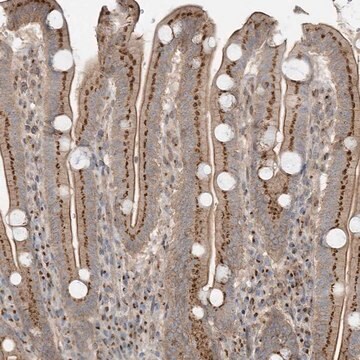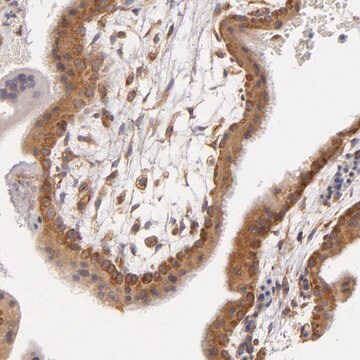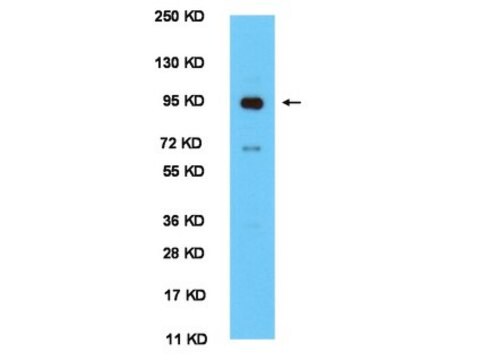おすすめの製品
由来生物
mouse
品質水準
結合体
unconjugated
抗体製品の状態
purified antibody
抗体製品タイプ
primary antibodies
クローン
MAC2-158, monoclonal
分子量
calculated mol wt 125.45 kDa
精製方法
using protein G
交差性
human
包装
antibody small pack of 100 μg
テクニック
flow cytometry: suitable
immunocytochemistry: suitable
immunohistochemistry (formalin-fixed, paraffin-embedded sections): suitable
immunoprecipitation (IP): suitable
western blot: suitable
アイソタイプ
IgG1κ
エピトープ配列
N-terminal
タンパク質IDアクセッション番号
UniProtアクセッション番号
輸送温度
ambient
ターゲットの翻訳後修飾
unmodified
詳細
Scavenger receptor cysteine-rich type 1 protein M130 (UniProt: Q86VB7; also known as Hemoglobin scavenger receptor, CD163) is encoded by the CD163 (also known as M130) gene (Gene ID: 9332) in human. CD163 is a single-pass type I membrane protein that is synthesized with a signal peptide (aa 1-41), which is subsequently cleaved off to produce the mature form that contains a long extracellular domain (aa 42-1050), a transmembrane domain (aa 1051-1071), and a cytoplasmic domain (aa 1072-1156). The extracellular domain contains nine scavenger receptor cysteine-rich (SRCR) scavenger receptor class B domains of about 100 amino acids each. SRCR domain 3 mediates calcium-sensitive interaction with Hemoglobin/Haptoglobin (Hb/Hp) complexes. CD163 is expressed in monocytes and mature macrophages with high expression observed in bone marrow macrophages, Kupffer cells, lung macrophages, and red pulp macrophages. Its levels are up regulated by anti-inflammatory mediators and suppressed by pro-inflammatory mediators like lipopolysaccharides (LPS) and TNF . It serves as an acute phase-regulated receptor involved in clearance and endocytosis of Hb/Hp complexes by macrophages and protects tissues from free hemoglobin-mediated oxidative damage. The binding of the Hb/Hp complex to CD163 macrophages leads to a fast degradation of the complex. CD163 also plays a role in the uptake and recycling of iron, via endocytosis of Hb/Hp complex and subsequent breakdown of heme. A soluble form of CF163 (sCD163) has also been described that is produced by proteolytic shedding and can be induced by LPS, phorbol ester, and Fc region of immunoglobulin . This soluble form plays an anti-inflammatory role and is considered a diagnostic parameter for monitoring macrophage activation in inflammatory conditions. Its expression is markedly induced by anti- inflammatory mediators, such as glucocorticoids and interleukin 10. Clone MAC2-158 binds to SRCR domain 1 of CD163 and recognizes over 80% of circulating CD14-expressing monocytes. (Ref.: Zhi, Y., et al. (2017). Mol. Med. Rep. 15(5); 2931-2939; Maniecki, MB., et al. (2011). Immunology 216(8); 882-890; Morganelli, PM., and Guyre, PM. (1988). J. Immunol. 140(7); 2296-2304).
特異性
Clone MAC2-158 is a mouse monoclonal antibody that detects human CD163. It targets an epitope within the SRCR1 domain from the N-terminal region.
免疫原
Interferon and Dexamethasone treated human monocytes.
アプリケーション
Quality Control Testing
Evaluated by Immunohistochemistry (Paraffin) in human thymus tissue sections.
Immunohistochemistry (Paraffin) Analysis: A 1:250 dilution of this antibody detected CD163 in human thymus tissue sections.
Tested Applications
Immunohistochemistry (Paraffin) Analysis: A 1:250 dilution from a representative lot detected CD163 in human liver tissue sections.
Flow Cytometry Analysis: A representative lot detected CD163 in Flow Cytometry applications Maniecki, M.B., et al. (2011). Immunobiology. 216(8): 882-90; Krijgsman, D., et al. (2020). Int J Mol Sci. 21(16): 5925).
Immunocytochemistry Analysis: A representative lot detected CD163 in Immunocytochemistry applications (Maniecki, M.B., et al. (2011). Immunobiology. 216(8): 882-90).
Flow Cytometry Analysis: A representative lot detected CD163 in human peripheral blood mononuclear cells (PBMC) (Data courtesy of Jane Collins, Research Laboratory Manager of Dr. Paul M. Guyre s Lab, Department of Microbiology and Immunology, Geisel School of Medicine, Dartmouth College, NH, USA).
Western Blotting Analysis: A representative lot detected CD163 in Western Blotting applications (Maniecki, M.B., et al. (2011). Immunobiology. 216(8): 882-90).
Immunoprecipitation Analysis: A representative lot immunoprecipitated CD163 in Immunoprecipitation applications (Morganelli, P.M., et al. (1988). J Immunol. 140(7): 2296-304).
Note: Actual optimal working dilutions must be determined by end user as specimens, and experimental conditions may vary with the end user
Evaluated by Immunohistochemistry (Paraffin) in human thymus tissue sections.
Immunohistochemistry (Paraffin) Analysis: A 1:250 dilution of this antibody detected CD163 in human thymus tissue sections.
Tested Applications
Immunohistochemistry (Paraffin) Analysis: A 1:250 dilution from a representative lot detected CD163 in human liver tissue sections.
Flow Cytometry Analysis: A representative lot detected CD163 in Flow Cytometry applications Maniecki, M.B., et al. (2011). Immunobiology. 216(8): 882-90; Krijgsman, D., et al. (2020). Int J Mol Sci. 21(16): 5925).
Immunocytochemistry Analysis: A representative lot detected CD163 in Immunocytochemistry applications (Maniecki, M.B., et al. (2011). Immunobiology. 216(8): 882-90).
Flow Cytometry Analysis: A representative lot detected CD163 in human peripheral blood mononuclear cells (PBMC) (Data courtesy of Jane Collins, Research Laboratory Manager of Dr. Paul M. Guyre s Lab, Department of Microbiology and Immunology, Geisel School of Medicine, Dartmouth College, NH, USA).
Western Blotting Analysis: A representative lot detected CD163 in Western Blotting applications (Maniecki, M.B., et al. (2011). Immunobiology. 216(8): 882-90).
Immunoprecipitation Analysis: A representative lot immunoprecipitated CD163 in Immunoprecipitation applications (Morganelli, P.M., et al. (1988). J Immunol. 140(7): 2296-304).
Note: Actual optimal working dilutions must be determined by end user as specimens, and experimental conditions may vary with the end user
This mouse monoclonal Anti-CD163, clone MAC2-158, Cat. No. MABF3068 is tested for use in Immunohistochemistry (Paraffin), Immunoprecipitation, Western Blotting, Flow Cytometry, Immunocytochemistry, for the detection of CD163.
物理的形状
Purified mouse monoclonal antibody IgG1 in buffer containing 0.1 M Tris-Glycine (pH 7.4), 150 mM NaCl with 0.05% sodium azide.
保管および安定性
Recommended storage: +2°C to +8°C.
その他情報
Concentration: Please refer to the Certificate of Analysis for the lot-specific concentration.
免責事項
Unless otherwise stated in our catalog or other company documentation accompanying the product(s), our products are intended for research use only and are not to be used for any other purpose, which includes but is not limited to, unauthorized commercial uses, in vitro diagnostic uses, ex vivo or in vivo therapeutic uses or any type of consumption or application to humans or animals.
適切な製品が見つかりませんか。
製品選択ツール.をお試しください
保管分類コード
12 - Non Combustible Liquids
WGK
WGK 1
適用法令
試験研究用途を考慮した関連法令を主に挙げております。化学物質以外については、一部の情報のみ提供しています。 製品を安全かつ合法的に使用することは、使用者の義務です。最新情報により修正される場合があります。WEBの反映には時間を要することがあるため、適宜SDSをご参照ください。
Jan Code
MABF3068-25UG:
MABF3068-100UG:
試験成績書(COA)
製品のロット番号・バッチ番号を入力して、試験成績書(COA) を検索できます。ロット番号・バッチ番号は、製品ラベルに「Lot」または「Batch」に続いて記載されています。
ライフサイエンス、有機合成、材料科学、クロマトグラフィー、分析など、あらゆる分野の研究に経験のあるメンバーがおります。.
製品に関するお問い合わせはこちら(テクニカルサービス)








